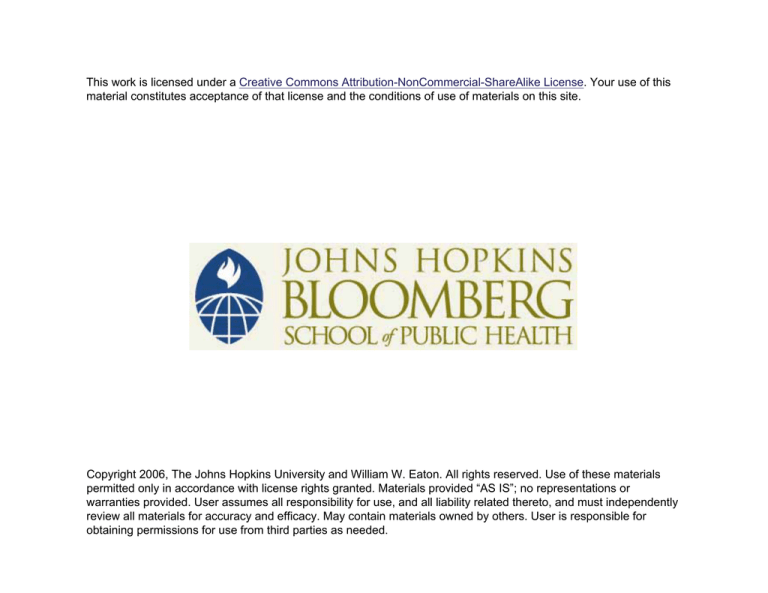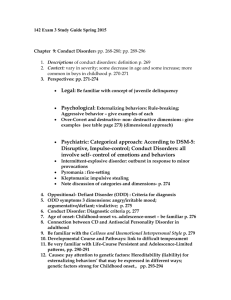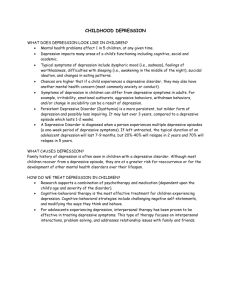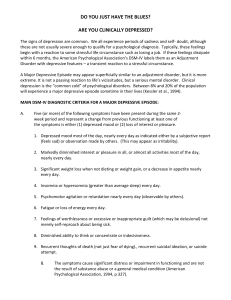
This work is licensed under a Creative Commons Attribution-NonCommercial-ShareAlike License. Your use of this
material constitutes acceptance of that license and the conditions of use of materials on this site.
Copyright 2006, The Johns Hopkins University and William W. Eaton. All rights reserved. Use of these materials
permitted only in accordance with license rights granted. Materials provided “AS IS”; no representations or
warranties provided. User assumes all responsibility for use, and all liability related thereto, and must independently
review all materials for accuracy and efficacy. May contain materials owned by others. User is responsible for
obtaining permissions for use from third parties as needed.
Epidemiology of Mood Disorders I:
Diagnosis, Descriptive
Epidemiology, and Natural History
William W. Eaton, PhD
Johns Hopkins University
Section A
Diagnosis
Stress-Reactive Neurosis
4
Anxiety and Depression
5
Major Depressive Episode: Diagnostic Criteria
At least one of the following three abnormal moods
significantly interfered with the person's life:
Ë Abnormal depressed mood most of the day,
nearly every day, for at least two weeks
Ë Abnormal loss of all interest and pleasure most
of the day, nearly every day, for at least two
weeks
Ë If 18 or younger, abnormal irritable mood most
of the day, nearly every day, for at least two
weeks
Continued
6
Major Depressive Episode (MDE): Diagnostic Criteria
At least five of the following symptoms have been
present during the same two week depressed period
1. Abnormal depressed mood
2. Abnormal loss of all interest and pleasure
3. Appetite or weight disturbance
4. Sleep disturbance
5. Abnormal agitation or abnormal slowing
6. Abnormal fatigue or loss of energy
7. Abnormal self-reproach or inappropriate guilt
8. Abnormal poor concentration or indecisiveness
9. Abnormal thoughts of death or suicide
Continued
7
Major Depressive Episode (MDE): Diagnostic Criteria
The symptoms are not due to a mood-incongruent
psychosis
There has never been a manic episode, a mixed
episode, or a hypo-manic episode
The symptoms are not due to physical illness, alcohol,
medication, or street drugs
The symptoms are not due to normal bereavement
T Notes Available
8
Durer: “Melancholia,” 1519
T Notes Available
9
Inheritance and Depression: Alfred Lord Tennyson
10
Excerpt from Maud, or, The Madness, by Alfred, Lord Tennyson
I hate the dreadful hollow behind the little wood,
Its lips in the field above are dabbled with blood-red heath,
The red-ribb’d ledges drip with a silent horror of blood,
And Echo there, whatever is aske’d her, answers “Death.”
For there in the ghastly pit long since a body was found,
His who had given me life– O father! O God! Was it well?
Mangled, and flatten’d, and crush’d, and dinted into the ground:
There yet lies the rock that fell with him when he fell.
…
What! Am I raging alone as my father raged in his mood?
Must I too creep to the hollow and dash myself down and die.
Rather than hold by the law that I made, nevermore to brood
On a horror of shatter’d limbs . . .?
….
11
Symptom Groups Related to Depressive Disorder
Dysphoric Episode
Anhedonia
Appetite
Sleep
Slow or restless
Fatigue
Guilt
Concentration
Thoughts of Death
Episode of Depressive Syndrome
Symptoms in 1 or more groups
Symptoms in 2 or more groups
Symptoms in 3 or more groups
Symptoms in 4 or more groups
Symptoms in 5 or more groups
T Notes Available
Any Occurrence Ever Worst Episode of Depression
27.9
12.0
9.3
5.6
20.7
7.0
22.1
8.4
9.8
3.7
17.1
5.0
6.3
4.2
11.7
6.9
21.0
7.1
12.0
11.8
10.6
9.6
7.6
12
Disability Adjusted Life Years by Cause
Developed Regions, 1990
Top Ten Causes
Ischaemic Heart Disease
Unipolar Major Depression
Cerebrovascular Disease
Road Traffic Accidents
Alcohol Use
Osteoarthritis
Lung and Throat Cancers
Dementia
Self-Inflicted Injuries
Congenital Anomalies
Less Important Causes
13. Schizophrenia
15. Bipolar Disorder
20. Obsessive-Compulsive Disorder
22. Drug Use
0
T Notes Available
2
4
6
8
10
12
Percentage of All DALY's
13
Section B
Descriptive Epidemiology of Major Depressive
Episode (MDE)
Summary of Descriptive Epidemiology of Seven Psychiatric Disorders
Diagnosis
Lifetime
prevalence
Autism
Attention Deficit
Conduct Disorder
Eating Disorders
Agoraphobic Disorder
Panic Disorder
Social Phobic Disorder
Alcohol Disorder
Major Depression
Schizophrenia
Bipolar Disorder
Dementia
0.05
6.2
5.4
1.2
5.3
1.6
1.7
13.0
9.0
0.3
0.6
4.9
T Notes Available
Interquartile
range
0.04-0.10
2.2-6.7
NA
1.0-2.8
3.6-5.7
1.1-2.2
1.7-2.7
10.7-15.9
8.4-16.0
0.16-0.56
0.4-0.8
3.6-7.2
Number Annual
of
incidence
studies per 1000
23
NA
6
NA
1
NA
7
0.18
7
22.0
11
1.4
6
4.0
15
17.9
15
3.0
25
0.2
9
0.3
23
6.0
15
12%
4
10.8
10
8
3.4
2
T Notes Available
2.9
1.8
0.9
0.8
0.8
0
M
So
an
m
ia
at
Sc
iza
hi
zo
tio
ph
n
re
ni
fo
rm
Ph
Al obi
co a
ho
Dy l A/D
st
hy
Co
m
gn
De ia
iti
pr
ve
es
Im
sio
pa
n
irm
en
Ob
t
se
D
ss
ru
iv
g
eA/
Co
D
m
pu
An
lsi
tive
so
cia
Pa
lP
ni
er
c
so
n
Sc
al
hi
zo ity
ph
re
ni
a
Prevalence of Disorder in the Past Six Months: ECA Program
Untreated
Treated
6
4.2
2.7
1.7
0.7
0.3
0.1
16
Prevalence of Depression in Percent-Selected Surveys
Place
N
Age
Leader
18,572
18+
Weissman
Puerto Rico
1551
17-64
Canino
4.6
Seoul
5100
18-65
Lee
3.4
Edmonton
3258
18+
Bland
8.6
New Zealand
1498
18+
Joyce
5.3
Zurich
6193
19-24
Angst
7.0
USA-NCS
8098
15-54
Kessler
10.3
USA-ECA
T Notes Available
One Year Lifetime
2.6
4.4
12.6
17.1
17
Attrition Experienced in Baltimore ECA Follow-Up
1981–1996
3481 Respondents in 1981
2,633 Survivors
2, 218 Located
1920 Interviewed in
1993–1996
(73% of Survivors)
848 Died (24% of cohort)
415 Not Located (16% of survivors)
298 Refused (13% of located)
18
DIS/DSM-IV MDE:
Cumulative Incidence in Baltimore ECA Follow-Up
Age in 1981
Males
18-29
30-44
45-64
65+
All ages
Females
18-29
30-44
45-64
65+
All ages
Total
T Notes Available
At Risk
New Cases
13-Year Incidence
237
186
145
62
630
9
7
2
0
18
3.8
3.8
1.4
0
2.9
332
305
281
117
1035
1665
31
16
4
2
53
71
9.3
5.2
1.4
1.7
4.6
3.9
19
Incidence of MDE
Baltimore ECA Followup
71 New Cases in 23,698 Person Years of Exposure
Adapted from: Eaton et al, Arch Gen Psychiatry, 1997
20
Section C
Natural History of Major Depressive Episode
The Natural History of Depression
Prodrome
Course
Ë Remission
Ë Recurrence
22
DIS/DSM-III Major Depressive Disorder
Cumulative Percent with Onset
Prodromal Period for New Cases
Epidemiologic Catchment Area Program
100
80
Onset of
Problem
60
Onset of
Disorder
40
20
0
0
5 10 15 20 25 30 35 40 45 50 55 60 65 70 75 80 85 90
Age in Years
T Notes Available
23
Duration of Prodrome by Symptom Group
Baltimore ECA Follow-Up
63
Dysphoria
43
Anhedonia
56
Appetite
62
Sleep
38
Slow/restless
47
Tired
35
Worthless
54
Thinking problems
Suicidal
0
5
10
15
20
25
49
30
35
Duration of Prodrome in Years
T Notes Available
24
Years to Recovery from Major Depressive Episode
Proportion Remaining in Episode
Baltimore ECA Follow-Up
1.0
1981 Case
1981 Case - Censored
.8
New Case
New Case -Censored
.6
Median
.4
.2
0.0
0
2
4
6
8
10
12
14
16
Years from End of Prior Episode to Recovery
T Notes Available
25
Years to Recurrence of Major Depressive Episode
Baltimore ECA Follow-Up
Proportion without Recurrence
1.0
.9
.8
.7
.6
Median
.5
.4
Censored
.3
0
10
20
30
Years from Recovery to Recurrence
T Notes Available
26
Section D
Major Depressive and Diabetes
Predictors of Non-Insulin Dependent Diabetes (Mellitus) Onset
Baltimore ECA Follow-Up
Type of Psychopathology
Odds Ratio
Dysphoric Episode
1.0
Depression Syndrome
1.0
Major Depression + Grief
1.8
Major Depression
2.2
Panic Disorder
1.1
Phobic Disorder
0.8
Alcohol Disorder
0.7
Obsessive Compulsive
1.2
* Models adjusted for age, sex, and BMI
28
Predictors of NIDDM Onset
Eight Year Follow-Up of 3066 Males in Japan
Variable
Odds Ratio
18–34
(1.0)
35–44
2.3
45 +
3.2
Body Mass Index
1.2
Zung Depression Scale
“Normal”
(1.0)
“Mild”
1.1
“Severe”
2.3
•
* Adjusted for smoking, alcohol consumption, physical exercise,
chronic medical conditions, family history of diabetes
T Notes Available
29
Incidence of Insulin Dependent Diabetes by Age and Sex
Allegheny County, Pennsylvania, 1965-1976
Per 100,000 Population per Year
25
White Males
White Females
20
15
10
5
0
< 5 Years
T Notes Available
5 to 9 Years
10 to 14 Years
15 to 19 Years
30
Incidence of Non-Insulin Dependent Diabetes by Age and Sex
Number of New Cases per 1000 Population per Year
10
Males
Females
8
6
4
2
0
0-24
T Notes Available
25-44
45-54
55-64
65-74
75+
31
Incidence of NIDDM,1981–1993/4
Baltimore ECA Follow-Up
Per 100,000 Population per Year
8
Male
Female
6
4
2
0
18-29
T Notes Available
30-44
45-64
65+
32
Incidence of MDE
Baltimore ECA Followup
71 New Cases in 23,698 Person Years of Exposure
Adapted from: Eaton et al, Arch Gen Psychiatry, 1997
33
Depression and Diabetes
Prospective Studies
Eaton 1996
Kawakami 1999
Golden 2002
Carnethon 2003
In Review
.8 .9 1
2
3
4
5
6
Odds Ratio
34
Section E
Major Depression and Other Health Conditions
Antecedent Depression and Myocardial Infarction
OR
No Dysphoria
1.0
Dysphoric Episode 1.7
Major Depression 2.6
Male
18-29
30-44
45-54
55-64
65 +
Married
Widowed
Divorced/Separated
Never Married
Hypertension
Alcohol Disorder
Phobic Disorder
Panic Disorder
Adapted from: Pratt, et al. (1996), Circulation
Model 1
95% CI
(1.00-3.00)
(1.06-6.35)
Model 3
OR
1.0
2.0
4.2
1.6
1.0
1.9
5.4
10.4
11.0
1.0
0.7
1.9
0.5
1.6
1.4
1.2
1.2
95% CI
(1.08-3.51)
(1.49-11.62)
(0.88-2.86)
(0.63-5.55)
(1.72-16.83)
(3.53-30.75)
(3.43-34.98)
(0.30-1.65)
(1.01-3.57)
(0.16-1.53)
(0.95-2.85)
(0.65-2.89)
(0.65-2.20)
(0.14-9.81)
36
Heart Attack and Antecedent Psychotropic Medications
Baltimore ECA Follow-Up
Barbituates
Number with MI
13
OR*
2.11
95% CI
1.07, 4.15
Benzodiazepines
21
1.33
0.74–2.38
Phenothiazines
7
2.48
1.00–6.17
Lithium
2
9.92
1.70–57.82
Tricyclics
6
1.3
0.52–3.29
Meprobamates
4
4.03
1.18–13.79
* Adjusted for gender, age, marital status, history of hypertension, and history of major
depressive episode or dysphoric episode.
Adapted from: Pratt, et al. (1996), Circulation
37
Depression and CHD
Prospective Studies
Anda, 1993
Barefoot, 1996
Pratt, 1996
Wassertheil, 1996
Ford, 1998
Mendes de L. 1998 F
Mendes de L. 1998 M
Schwartz, 1998
Sesso, 1998
Whooley, 1998
Ferketich, 2000 F
Ferketich, 2000 M
.4
.6 .8 1
2
4
6 8 10
20
Odds Ratios
Adapted from: Rugelies (2002), Am J Prev Med.
38
Depression as Predictor of Onset of Physical Conditions
Baltimore ECA Follow-Up
Condition
First Author Relative Odds
Journal
Type II Diabetes
Eaton
2.2
Diabetes Care
Heart Attack
Pratt
4.0
Circulation
Migraine
Swartz
1.0
Arch Gen Psychiatry
Breast Cancer
Gallo
3.9
Cancer Causes and Control
Stroke
Larson
3.6
Stroke
Arthritis
Armenian
1.2
Not published
39
Depression and Stroke
Prospective Studies
Colantonio 1992
Everson 1998
Simons 1998
Jonas 2000
Larson 2001
Ohira 2001
May 2002
.8
.1
2
3
4
5
6
7
40
Depression and Breast Cancer
Prospective Studies
Hahn, 1988
Hjerl, 1999
Gallo, 2000
Lillberg, 2002
Nyklicek, 2003
.1
.2 .3 .4 .5
1
2 3 45
10
20
Odds Ratios
41
Depression and Osteoporosis
Prospective Studies
Schweiger, 1994 F
Schweiger, 1994 M
Michelson, 1996 F
Coelho, 1999 F
Whooley, 1999 F
Schweiger, 2000 F
Schweiger, 2000 M
-4
-3
-2
-1
0
1
Mean Difference in Spine Bone Density
42
Depression and Dementia
Prospective Studies
Buntinx, 1996
Devanand, 1996
Kessing, 1998
Chen, 1999
Palsson, 1999
Geerlings, 2000
.6
.8 1
2
4
6
8 10
20
Odds Ratio
Adapted from: Jorm (2001), Aust NZ J Psychiatry
43
Single Source Diathesis with Multiple Endpoints
Depression
Diabetes
Heart Attack
Diathesis
Osteoporosis
Stroke
Dementia
Birth
15
30
45
60
75
44
Multiple Source Diathesis with Multiple Endpoints
Diabetes
Conception?
Birth?
Heart Attack
Diathesis
Childhood?
Osteoporosis
Depression
Stroke
Life Stress
Birth
Dementia
15
30
45
60
75
45
Conditions as Mediators:
Multiple Source Diathesis with Multiple Chains
of Cause and Multiple Endpoints
Diabetes
Conception?
Heart Attack
Diathesis
Birth?
Childhood?
Osteoporosis
Depression
Stroke
Life Stress
Birth
Dementia
15
30
45
60
75
46
Psychopathology, Chronic Illness, and Disability
No
Yes
No
Yes
Chronic
Illness in
1981 *
No
No
Yes
Yes
Phobia in 1981
No
Yes
No
Yes
No
No
Yes
Yes
Major Depression
in 1981
Number at
Incidence of
Risk of
Disability Disability (%)
900
2.1
38
10.5
845
14
38
26.3
739
215
666
233
2
4.7
13.1
18.9
Adjusted
Relative
Risk **
1
5
3.6
17
1
2.5
3.6
6.4
* One or more of asthma, arthritis, heart disease, hypertension, or diabetes
** Adjusted for age and gender
Data from: Armenian (1998), et al., Am J Epidemiol.
47








